Land Degradation Vulnerability Mapping in a Newly-Reclaimed Desert Oasis in a Hyper-Arid Agro-Ecosystem Using AHP and Geospatial Techniques
Abstract
:1. Introduction
2. Materials and Methods
2.1. Area of Study
2.1.1. Climate
2.1.2. Land Use/Land Cover
2.1.3. Geology
2.2. Data Used
Remote Sensing Data
2.3. Field Work and Laboratory Analyses
2.4. Wind Erosion Calculation
- Climatic Erosive Factor (CE)
- Wind-Erodible Fraction Factor (EF)
- Soil Crust Factor (SCF)
- Vegetation Cover Factor (VCF)
- Surface Roughness Factor (SRF)
2.5. Modelling Land Degradation Vulnerability
- Selecting and Generating Thematic Layers of LDV Criteria
2.5.1. Generating LDV Indices
2.5.2. Geostatistical Analysis
2.5.3. Generating the Final LDV Map
2.6. Model Validation
3. Results
3.1. Geology Index (GI)
3.2. Topographic Quality Index (TQI)
3.3. Physical Soil Quality Index (PSQI)
3.4. Chemical Soil Quality Index (CSQI)
3.5. Wind Erosion Quality Index (WEQI)
3.6. Vegetation Quality Index (VQI)
3.7. The Overall LDV Map
3.8. Validation
4. Discussion
4.1. Geology
4.2. Topography
4.3. Physical Soil Quality
4.4. Chemical Soil Quality
4.5. Wind Erosion Quality
4.6. Vegetation Quality
4.7. The Final LDV Map
4.8. Validation
5. Conclusions
Author Contributions
Funding
Institutional Review Board Statement
Informed Consent Statement
Acknowledgments
Conflicts of Interest
References
- Cherlet, M.; Hutchinson, C.; Reynolds, J.; Hill, J.; Sommer, S.; Von Maltitz, G. World Atlas of Desertification; Publications Office of the European Union: Luxembourg, 2018. [Google Scholar]
- Lucatello, S.; Huber-Sannwald, E. Sustainable development goals and drylands: Addressing the interconnection. In Stewardship of Future Drylands and Climate Change in the Global South: Challenges and Opportunities for the Agenda 2030; Lucatello, S., Huber-Sannwald, E., Espejel, I., Martínez-Tagüeña, N., Eds.; Springer International Publishing: Cham, Switzerland, 2020; pp. 27–40. [Google Scholar]
- Barman, A.; Basak, N.; Narjary, B.; Mitran, T. Land degradation assessment using geospatial techniques. In Geospatial Technologies for Crops and Soils; Mitran, T., Meena, R.S., Chakraborty, A., Eds.; Springer: Singapore, 2021; pp. 421–453. [Google Scholar]
- Fargette, M.; Loireau, M.; Sghaier, M.; Raouani, N.; Libourel, T. The future ofoases in North Africa through the prism of a systemic approach: Towards which type of viability and coviability? In Coviability of Social and Ecological Systems: Reconnecting Mankind to the Biosphere in an Era of Global Change: Vol. 2: Coviability Questioned by a Diversity of Situations; Barrière, O., Ed.; Springer International Publishing: Cham, Switzerland, 2019; pp. 19–59. [Google Scholar]
- Ling, H.; Xu, H.; Fu, J.; Fan, Z.; Xu, X. Suitable oasis scale in a typical continental river basin in an arid region of China: A case study of the Manas River Basin. Quat. Int. 2013, 286, 116–125. [Google Scholar] [CrossRef]
- Yang, R.; Su, Y.; Kong, J. Effect of tillage, cropping, and mulching pattern on crop yield, soil C and N accumulation, and carbon footprint in a desert oasis farmland. Soil Sci. Plant Nutr. 2017, 63, 599–606. [Google Scholar] [CrossRef] [Green Version]
- Fadl, M.E.; Abuzaid, A.S. Assessment of land suitability and water requirements for different crops in Dakhla Oasis, Western Desert, Egypt. Int. J. Plant Soil Sci. 2017, 16, 1–16. [Google Scholar] [CrossRef] [Green Version]
- Abuzaid, A.S.; Abdellatif, A.D. Integration of multivariate analysis and spatial modeling to assess agricultural potentiality in Farafra Oasis, Western Desert of Egypt. Egypt. J. Soil Sci. 2021, 61, 171–180. [Google Scholar]
- Shalaby, A.; Khedr, H.S. Remote Sensing and GIS for Land Use/Land Cover Change Detection in Dakhla Oasis. In Sustainable Water Solutions in the Western Desert, Egypt: Dakhla Oasis; Iwasaki, E., Negm, A.M., Elbeih, S.F., Eds.; Springer International Publishing: Cham, Switzerland, 2021; pp. 145–159. [Google Scholar]
- Mohamed, S.H.I. The Egyptian Western Desert: Water, agriculture and culture of oasis communities. In Sustainable Water Solutions in the Western Desert, Egypt: Dakhla Oasis; Iwasaki, E., Negm, A.M., Elbeih, S.F., Eds.; Springer International Publishing: Cham, Switzerland, 2021; pp. 13–26. [Google Scholar]
- Corti, G.; Cocco, S.; Hannachi, N.; Cardelli, V.; Weindorf, D.; Marcellini, M.; Agnelli, A. Assessing geomorphological and pedological processes in the genesis of pre-deserts oils from southern Tunisia. CATENA 2020, 187, 104290. [Google Scholar] [CrossRef]
- Pei, H.; Fang, S.; Lin, L.; Qin, Z.; Wang, X. Methods and applications for ecological vulnerability evaluation in a hyper-arid oasis: A case study of the Turpan Oasis, China. Environ. Earth Sci. 2015, 74, 1449–1461. [Google Scholar] [CrossRef] [Green Version]
- Elbeih, S.F.; Zaghloul, E.A. Hydrologeological and hydrological conditions of Dakhla Oasis. In Sustainable Water Solutions in the Western Desert, Egypt: Dakhla Oasis; Iwasaki, E., Negm, A.M., Elbeih, S.F., Eds.; Springer International Publishing: Cham, Switzerland, 2021; pp. 185–201. [Google Scholar]
- Liu, X.X.; Xie, Y.; Zhou, D.; Li, X.; Ding, J.; Wu, X.; Wang, J.; Hai, C. Soil grain-size characteristics of Nitrariatangutorum Nebkhas with different degrees of vegetation coverage in a Desert-Oasis ecotone. Pol. J. Environ. Stud. 2020, 29, 3703–3714. [Google Scholar] [CrossRef]
- King, C.; Thomas, D.S.G. Monitoring environmental change and degradation in the irrigated oases of the Northern Sahara. J. Arid Environ. 2014, 103, 36–45. [Google Scholar] [CrossRef]
- Sandeep, P.; Reddy, G.P.O.; Jegankumar, R.; Kumar, K.C.A. Modeling and Assessment of Land Degradation Vulnerability in Semi-arid Ecosystem of Southern India Using Temporal Satellite Data, AHP and GIS. Environ. Model. Assess. 2021, 26, 143–154. [Google Scholar] [CrossRef]
- Parmar, M.; Bhawsar, Z.; Kotecha, M.; Shukla, A.; Rajawat, A.S. Assessment of land degradation vulnerability using geospatial technique: A case study of Kachchh District of Gujarat, India. J. Indian Soc. Remote Sens. 2021. [Google Scholar] [CrossRef]
- AbdelRahman, M.A.E.; Shalaby, A.; Aboelsoud, M.H.; Moghanm, F.S. GIS spatial model based for determining actual land degradation status in Kafr El-SheikhG overnorate, North Nile Delta. Model. Earth Syst. Environ. 2018, 4, 359–372. [Google Scholar] [CrossRef]
- AbdelRahman, M.A.E.; Tahoun, S. GIS model-builder based on comprehensive geostatistical approach to assesss oil quality. Remote Sens. Appl. Soc. Environ. 2019, 13, 204–214. [Google Scholar]
- Hereher, M.; El-Kenawy, A. Assessment of land degradation in northern Oman using geospatial techniques. Earth Syst. Environ. 2021. [Google Scholar] [CrossRef]
- Turan, İ.D.; Dengiz, O.; Özkan, B. Spatial assessment and mapping of soil quality index for desertification in the semi-arid terrestrial ecosystem using MCDM in interval type-2 fuzzy environment. Comput. Electron. Agric. 2019, 164, 104933. [Google Scholar] [CrossRef]
- Abuzaid, A.S.; Bassouny, M.A. Multivariate and spatial analysis of soil quality in Kafr El-Sheikh Governorate, Egypt. J. Soil Sci. Agric. Eng. Mansoura Univ. 2018, 9, 333–339. [Google Scholar] [CrossRef]
- Jahin, H.S.; Abuzaid, A.S.; Abdellatif, D.A. Using multivariate analysis to develop irrigation water quality index for surface water in Kafr El-Sheikh Governorate, Egypt. Environ. Technol. Innov. 2020, 17, 100532. [Google Scholar] [CrossRef]
- Abuzaid, A.S.; Jahin, H.S. Profile distribution and source identification of potentially toxic elements in north Nile Delta, Egypt. Soil Sediment Contam. Int. J. 2019, 28, 582–600. [Google Scholar] [CrossRef]
- Sutadian, A.D.; Muttil, N.; Yilmaz, A.G.; Perera, B. Using the Analytic Hierarchy Process to identify parameter weights for developing a water quality index. Ecol. Indic. 2017, 75, 220–233. [Google Scholar]
- Saaty, T.L. The Analytic Hierarchy Process; McGraw-Hill: New York, NY, USA, 1980. [Google Scholar]
- Saaty, T.L. Decision Making with the Analytic Hierarchy Process. Int. J. Serv. Sci. 2008, 1, 83–98. [Google Scholar]
- Kacem, H.A.; Fal, S.; Karim, M.; Alaoui, H.M.; Rhinane, H.; Maanan, M. Application of fuzzy analytical hierarchy process for assessment of desertification sensitive areas in North West of Morocco. Geocarto Int. 2021, 36, 563–580. [Google Scholar] [CrossRef]
- Bakr, N.; Bahnassy, M.H. Land use/land cover and vegetation status. In The Soils of Egypt; El-Ramady, H., Alshaal, T., Bakr, N., Elbana, T., Mohamed, E., Belal, A.A., Eds.; Springer International Publishing: Cham, Switzerland, 2019; pp. 51–67. [Google Scholar]
- Abuzaid, A.S.; Abdellatif, A.D.; Fadl, M.E. Modeling soil quality in Dakahlia Governorate, Egypt using GIS techniques. Egypt. J. Remote Sens. Space Sci. 2021, 24, 255–264. [Google Scholar] [CrossRef]
- Abuzaid, A.S. Assessing degradation of Flood Plain soils in north east Nile Delta, Egypt. Egypt. J. Soil Sci. 2018, 58, 135–146. [Google Scholar]
- Shihab, T.H.; Al-hameedawi, A.N. Desertification hazard zonation in central Iraq using multi-criteria evaluation and GIS. J. Indian Soc. Remote Sens. 2020, 48, 397–409. [Google Scholar] [CrossRef]
- Wang, J.; Liu, D.; Ma, J.; Cheng, Y.; Wang, L. Development of a large-scale remote sensing ecological index in arid areas and its application in the Aral Sea Basin. J. Arid Land 2021, 13, 40–55. [Google Scholar] [CrossRef]
- Bakr, N.; Weindorf, D.; Bahnassy, M.H.; El-Badawi, M.M. Multi-temporal assessment of land sensitivity to desertification in a fragilea gro-ecosystem: Environmental indicators. Ecol. Indic. 2012, 15, 271–280. [Google Scholar] [CrossRef]
- Mohamed, E.S. Spatial assessment of desertification in north Sinai using modified MEDLAUS model. Arab. J. Geosci. 2013, 6, 4647–4659. [Google Scholar] [CrossRef]
- Gad, A. Remotely sensed data for assessment of land degradation aspects, emphases on Egyptian case studies. In Sustainable Energy Investment—Technical, Market and Policy Innovations to Address Risk; Nyangon, J., Byrne, J., Eds.; IntechOpen: London, UK, 2021; pp. 181–201. [Google Scholar] [CrossRef]
- Haidara, I.; Tahri, M.; Maanan, M.; Hakdaoui, M. Efficiency of Fuzzy Analytic Hierarchy Process to detect soil erosion vulnerability. Geoderma 2019, 354, 113853. [Google Scholar] [CrossRef]
- Soil Survey Staff. Keys to Soil Taxonomy, 12th ed.; USDA-Natural Resources Conservation Service: Washington, DC, USA, 2014.
- EGPC/CONCO-Coral. Geologic Map of Egypt, Scale 1:500000, Cairo, Egypt; EGPC/CONCO-Coral: Cairo, Egypt, 1987. [Google Scholar]
- Kosmas, C.; Ferrara, A.; Briasouli, H.; Imeson, A. Methodology form appling environmentally sensitive areas (ESAS) to desertification. In The Medalus Project: Mediterranean Desertification and Land Use. Manual on Key Indicators of Desertification and Mapping Environmentally Sensitive Areas to Desertification; Kosmas, C., Kirkby, M., Geeson, N., Eds.; EUR18882; Office for Official Pubolications of the European Communities: Luxembourg, 1999. [Google Scholar]
- FAO. Guidelines for Soil Description; FAO: Rome, Italy, 2006. [Google Scholar]
- Sharma, T.; Singh, O. Soil erosion susceptibility assessment through geo-statistical multivariate approach in Panchkula district of Haryana, India. Model. Earth Syst. Environ. 2017, 3, 733–753. [Google Scholar] [CrossRef]
- FAO. A Provisional Methodology for Soil Degradation Assessment; FAO: Rome, Italy, 1980. [Google Scholar]
- Soil Science Division Staff. Soil Survey Manual. USDA Handbook 18; Government Printing Office: Washington, DC, USA, 2017.
- Fenta, A.A.; Tsunekawa, A.; Haregeweyn, N.; Poesen, J.; Tsubo, M.; Borrelli, P.; Panagos, P.; Vanmaercke, M.; Broeckx, J.; Yasuda, H.; et al. Land susceptibility to water and wind erosion risks in the East Africa region. Sci. Total Environ. 2020, 703, 135016. [Google Scholar] [CrossRef]
- Borrelli, P.; Ballabio, C.; Panagos, P.; Montanarella, L. Wind erosion susceptibility of European soils. Geoderma 2014, 234, 471–478. [Google Scholar] [CrossRef]
- Mandakh, N.; Tsogtbaatar, J.; Dash, D.; Khudulmur, S. Spatial assessment of soil wind erosion using WEQ approach in Mongolia. J. Geogr. Sci. 2016, 26, 473–483. [Google Scholar] [CrossRef] [Green Version]
- Zhang, S.; Chen, H.; Fu, Y.; Niu, H.; Yang, Y.; Zhang, B. Fractional vegetation covere stimation of different vegetation types in the Qaidam basin. Sustainability 2019, 11, 1–17. [Google Scholar]
- Bernard, J.; Bocher, E.; Petit, G.; Palominos, S. (2018) Sky view factor calculation in urban context: Computational performance and accuracy analysis of two open and free GIS tools. Climate 2018, 6, 60. [Google Scholar] [CrossRef] [Green Version]
- Soil Survey Staff. Soil Survey Field and Laboratory Methods Manual. Soil Survey Investigations Report No. 51, Version 2.0; Burt, R., Ed.; Department of Agriculture, Natural Resources Conservation Service: Washington, DC, USA, 2014.
- Jarrah, M.; Mayel, S.; Tatarko, J.; Funk, R.; Kuka, K. A review of wind erosio nmodels: Data requirements, processes, and validity. Catena 2020, 187, 104388. [Google Scholar] [CrossRef]
- Zhen, J.; Pei, T.; Xie, S. Kriging methods with auxiliary night time lights data to detect potentially toxic metals concentrations in soil. Sci. Total Environ. 2019, 659, 363–371. [Google Scholar] [CrossRef] [PubMed]
- Aldabaa, A.A.A.; Yousif, I.A.H. Geostatistical approach for land suitability assessment of some desert soils. Egypt. J. Soil Sci. 2020, 60, 195–209. [Google Scholar] [CrossRef]
- Mousavifard, S.M.; Momtaz, H.; Sepehr, E.; Davatgar, N.; Sadaghiani, M.H.R. Determining and mapping some soil physico-chemical properties using geostatistical and GIS techniques in the Naqade region, Iran. Arch. Agron. Soil Sci. 2013, 59, 1573–1589. [Google Scholar] [CrossRef]
- Ben Mahmoud, K.R.; Zurqani, H.A. Soil forming factors and processes. In The Soils of Libya; Zurqani, H.A., Ed.; Springer International Publishing: Cham, Switzerland, 2021; pp. 33–48. [Google Scholar]
- Osman, K.T. Factors and Processes of Soil Formation. In Soils: Principles, Properties and Management; Osman, K.T., Ed.; Springer: Dordrecht, The Netherlands, 2013; pp. 17–30. [Google Scholar]
- Chapin, F.S.; Matson, P.A.; Vitousek, P.M. Geology, soils, and sediments. In Principles of Terrestrial Ecosystem Ecology; Chapin, F.S., Matson, P.A., Vitousek, P.M., Eds.; Springer: New York, NY, USA, 2011; pp. 63–90. [Google Scholar]
- John, K.; Afu, S.M.; Isong, I.A.; Aki, E.E.; Kebonye, N.M.; Ayito, E.O.; Chapman, P.A.; Eyong, M.O.; Penížek, V. Mapping soil properties with soil-environmental covariates using geostatistics and multivariate statistics. Int. J. Environ. Sci. Technol. 2021. [Google Scholar] [CrossRef]
- Haghighi, A.T.; Darabi, H.; Karimidastenaei, Z.; Davudirad, A.A.; Rouzbeh, S.; Rahmati, O.; Sajedi-Hosseini, F.; Klöve, B. Land degradation risk mapping using topographic, human-induced, and geo-environmental variables and machine learning algorithms, for the Pole-Doab watershed, Iran. Environ. Earth Sci. 2020, 80, 1. [Google Scholar] [CrossRef]
- Abuzaid, A.S.; Fadl, M.E. Land evaluation of eastern Suez Canal, Egypt using remote sensing and GIS. Egypt. J. Soil Sci. 2016, 56, 537–548. [Google Scholar]
- Blume, H.-P.; Brümmer, G.W.; Fleige, H.; Horn, R.; Kandeler, E.; Kögel-Knabner, I.; Kretzschmar, R.; Stahr, K.; Wilke, B.M. Soil development and soil classification. In Scheffer/Schachtschabel Soil Science; Blume, H.-P., Brümmer, G.W., Fleige, H., Horn, R., Kandeler, E., Kögel-Knabner, I., Kretzschmar, R., Stahr, K., Wilke, B.-M., Eds.; Springer: Berlin/Heidelberg, Germany, 2016; pp. 285–389. [Google Scholar]
- Osman, K.T. Drylan soils. In Management of Soil Problems; Osman, K.T., Ed.; Springer International Publishing: Cham, Switzerland, 2018; pp. 15–36. [Google Scholar]
- Guo, Z.; Chang, C.; Wang, R.; Li, J. Comparison of different methods to determine wind-erodible fraction of soil with rock fragments under different tillage/management. Soil Tillage Res. 2017, 168, 42–49. [Google Scholar] [CrossRef]
- Desert Research Center (DRC). Egyptian National Action Program to Combat Desertification; DRC, Ministry of Agriculture and Land Reclamation (MALR): Cairo, Egypt, 2005. [Google Scholar]

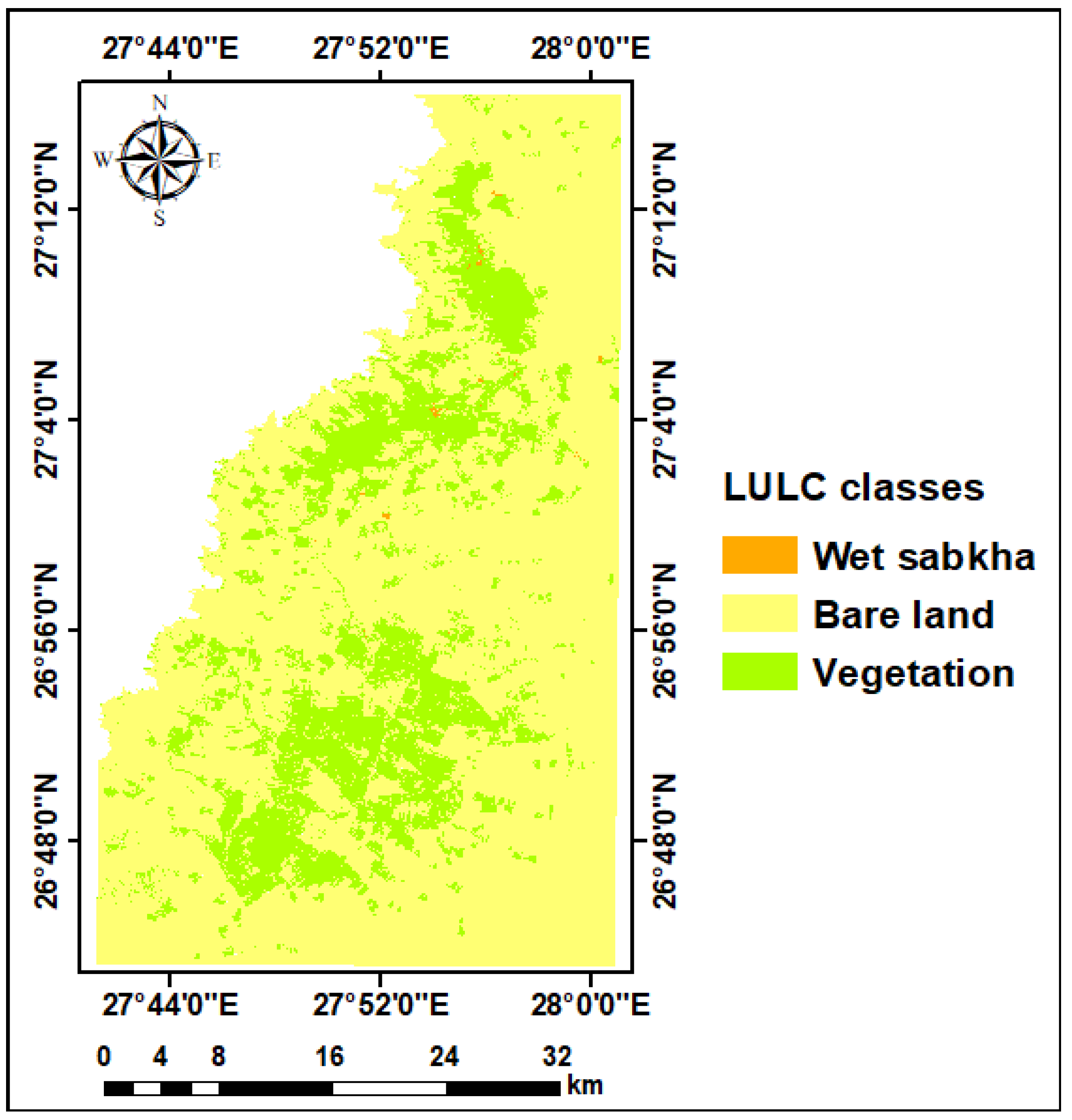
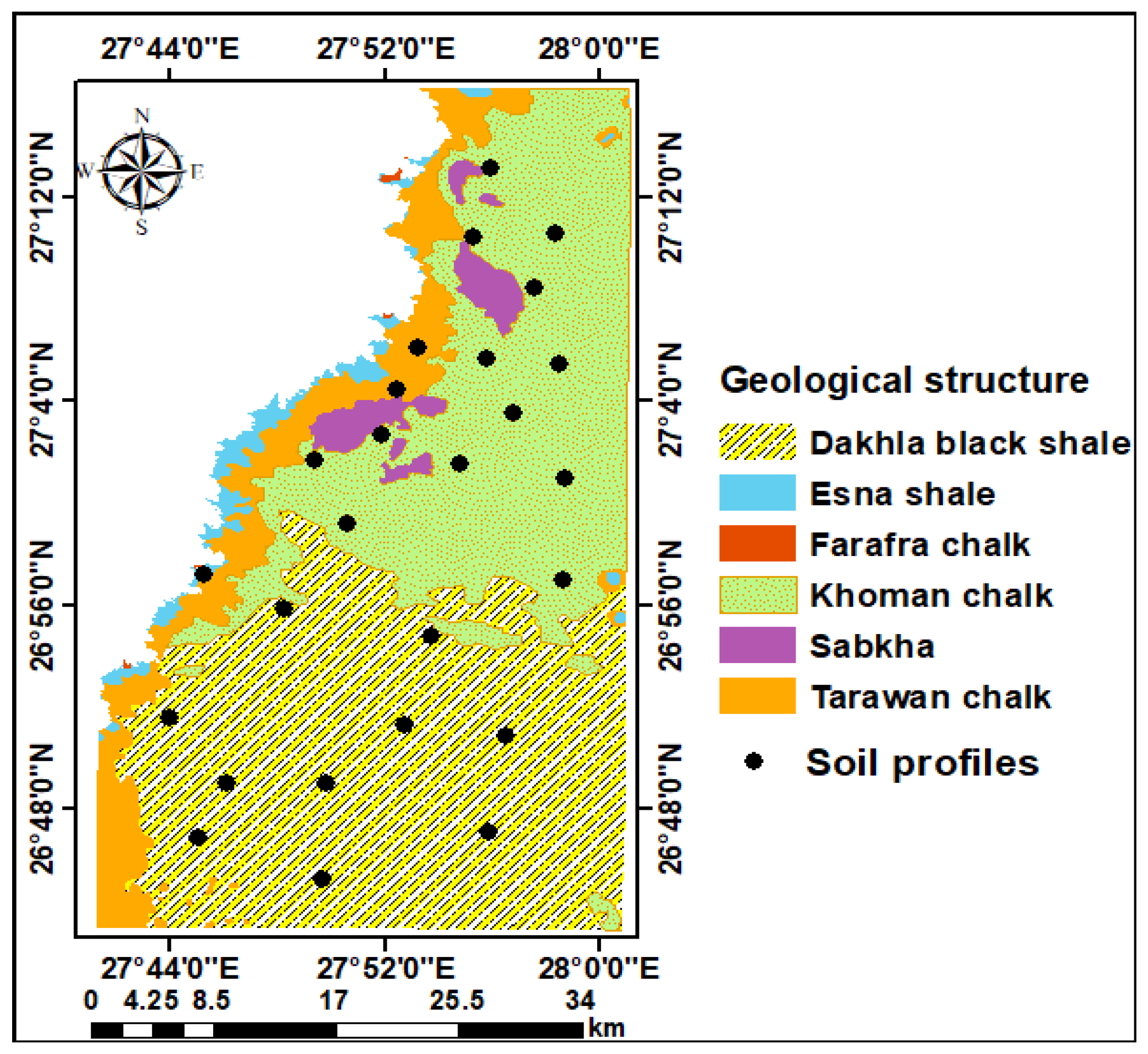
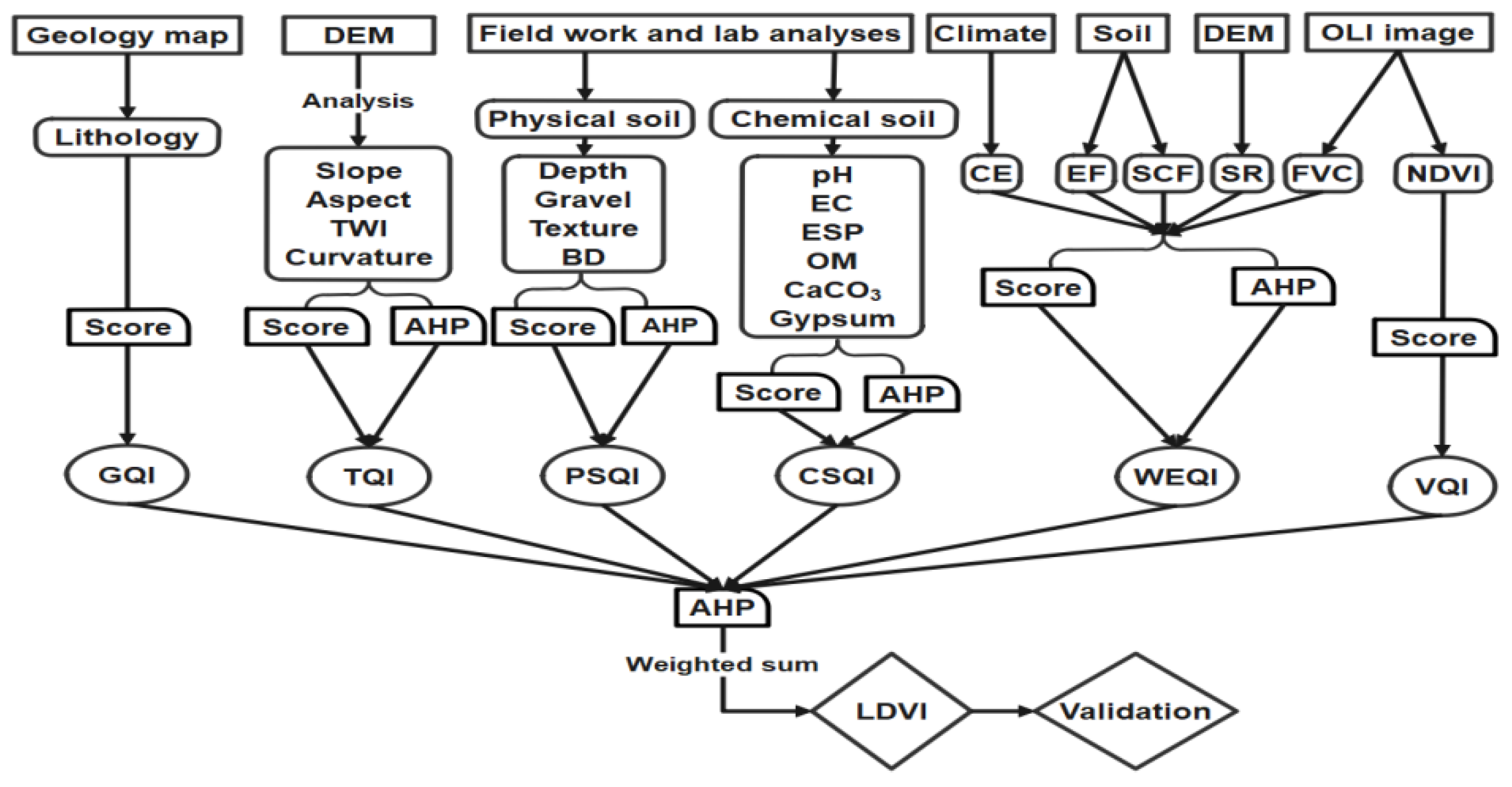
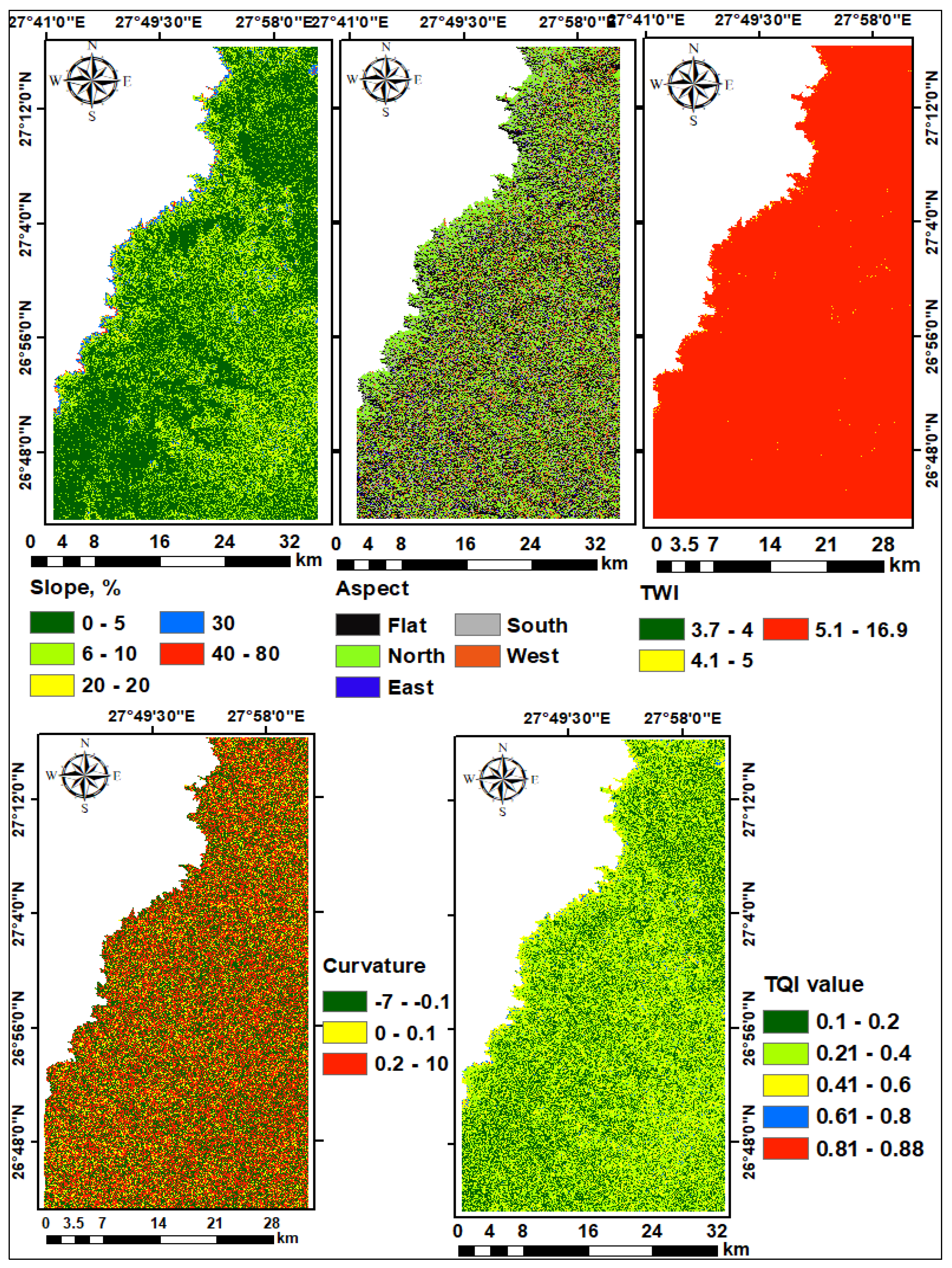
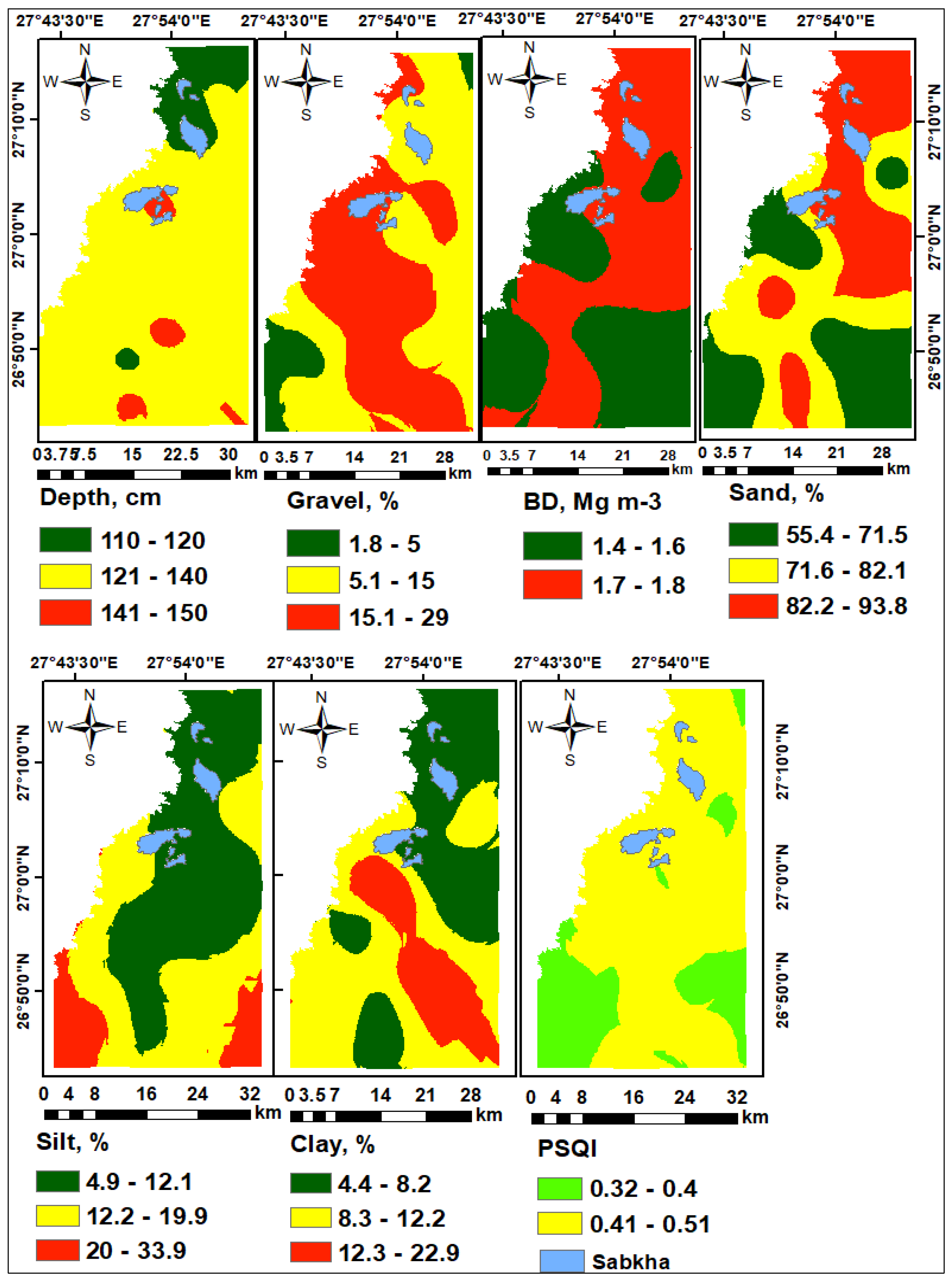
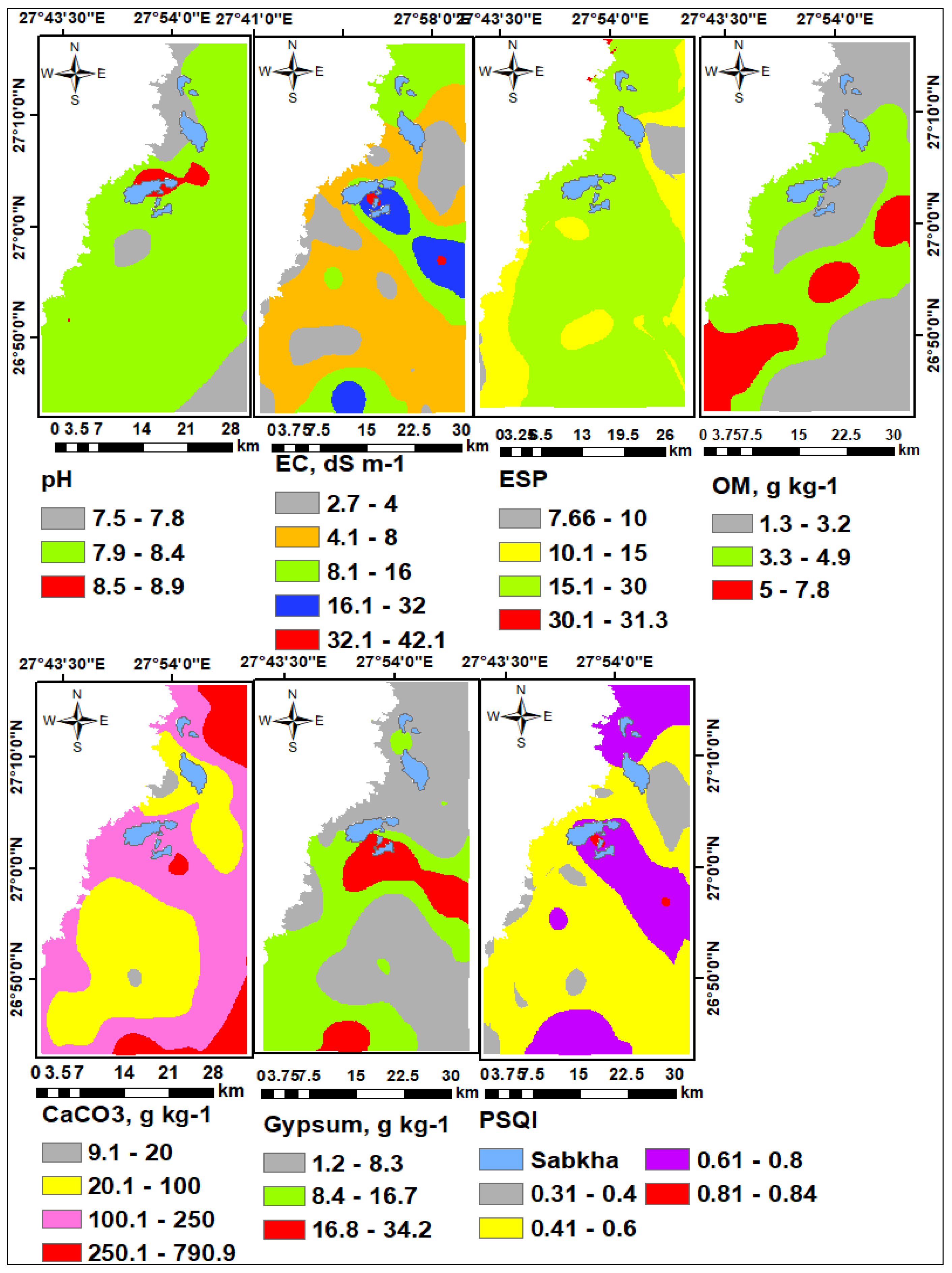
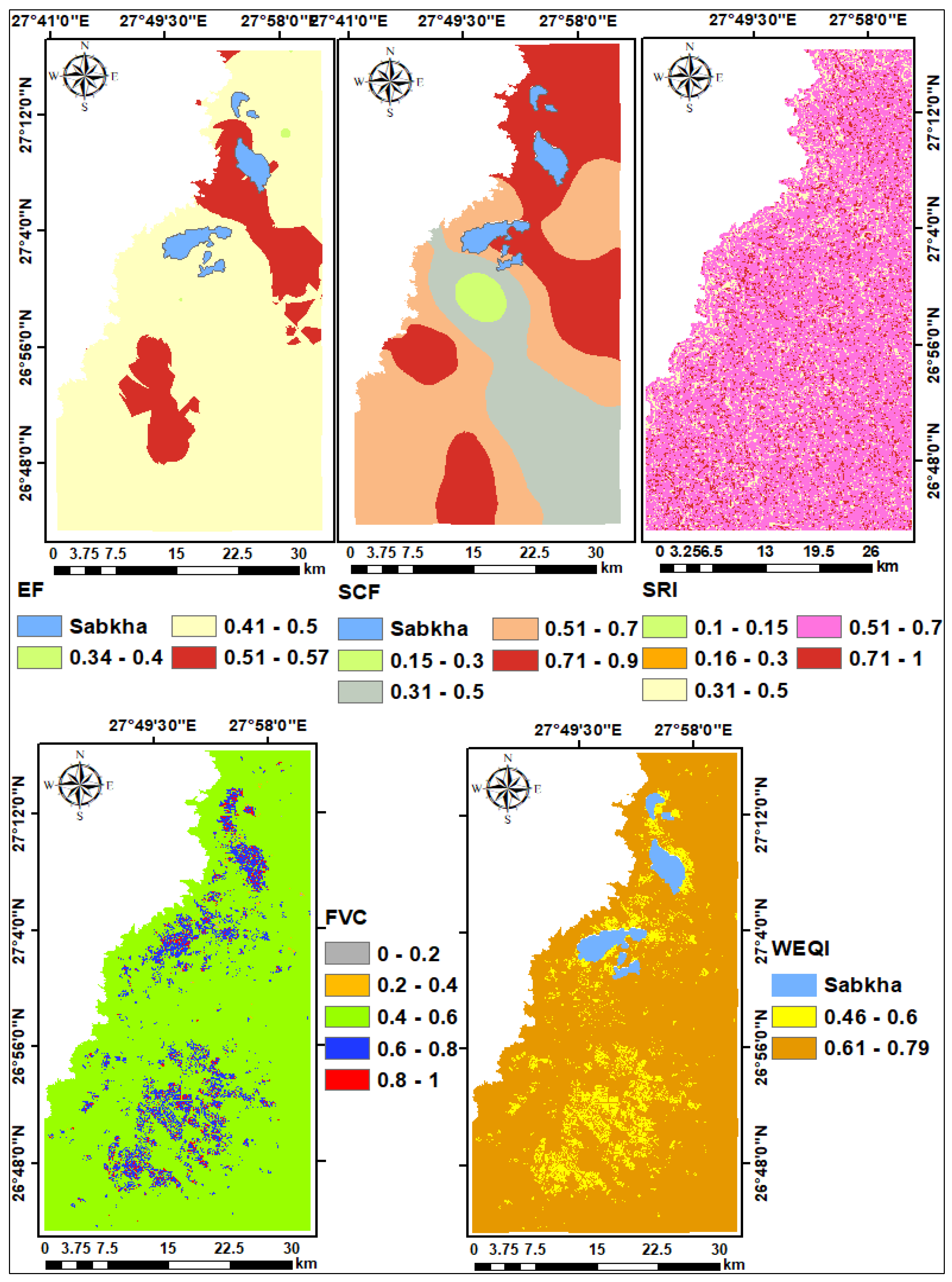
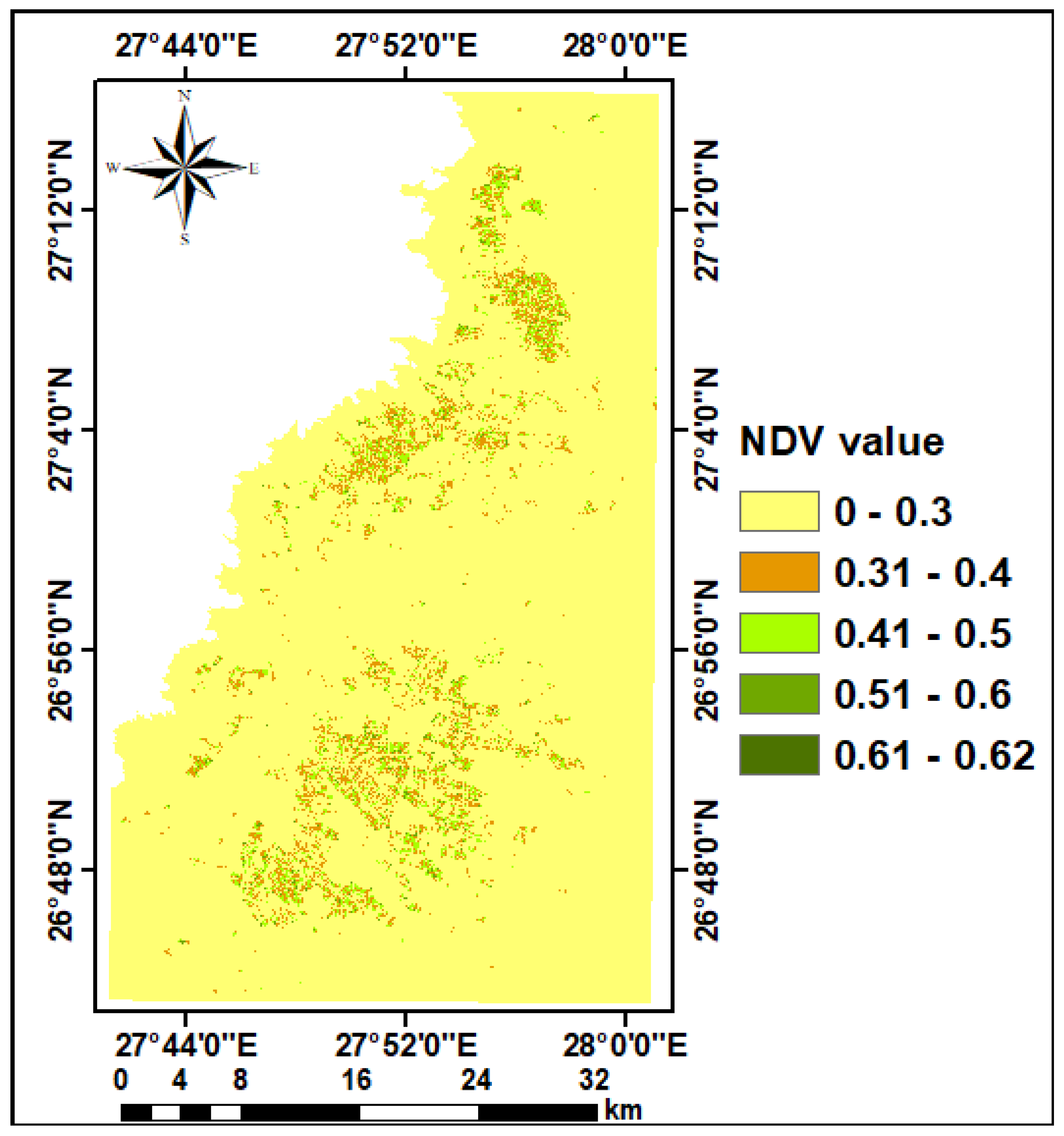
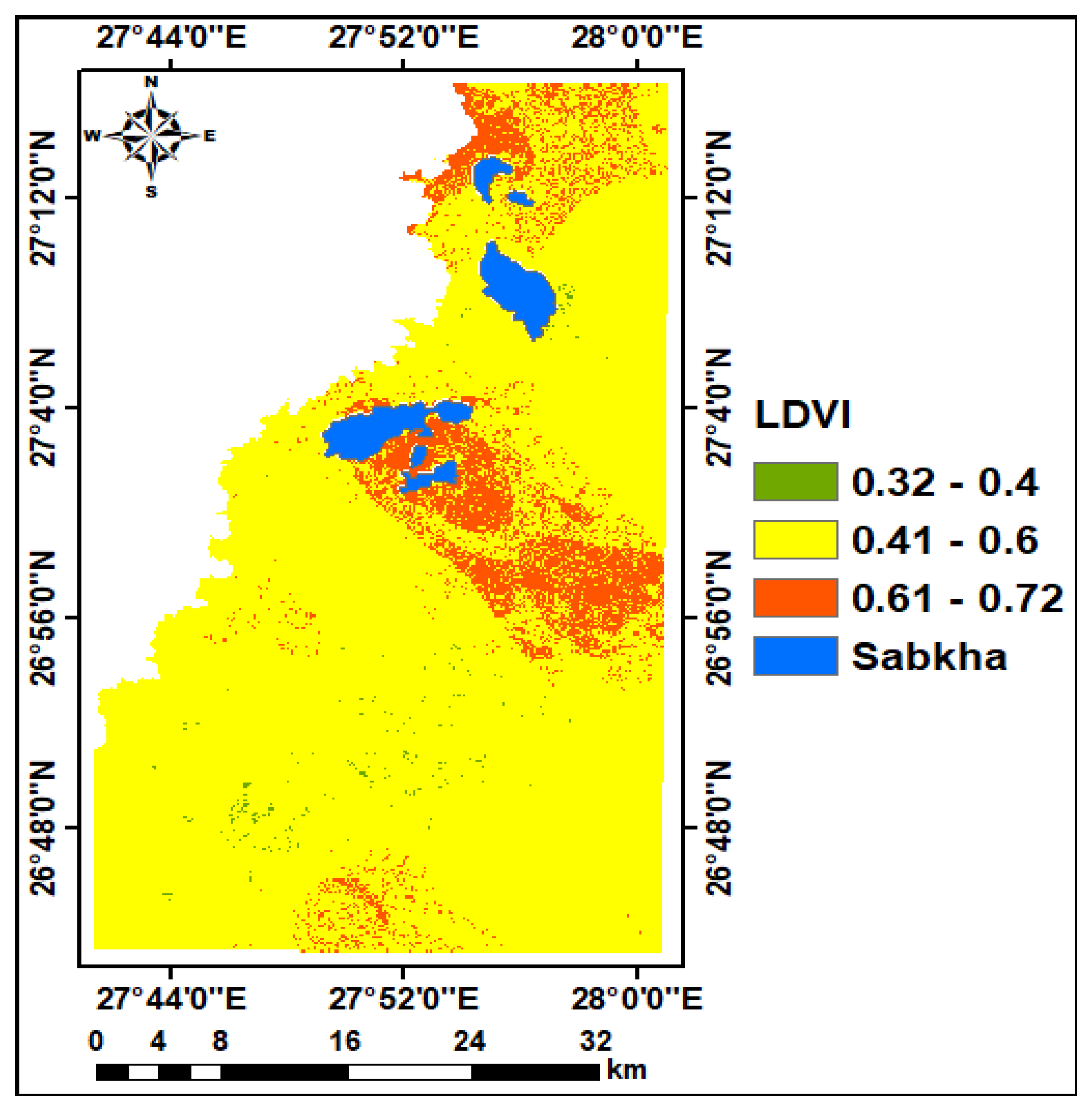
| Index | Parameter | Class | Description | Score | Reference |
|---|---|---|---|---|---|
| Geology | Parent material | 1 | Shale, schist, basic, ultra-basic, Conglomerates, unconsolidate | 0.1 | [40] |
| 2 | Limestone, marble, granite, Rhyolite, Ignibrite, gneiss, siltstone, sandstone | 0.5 | |||
| 3 | Marl, Pyroclastics | 1.0 | |||
| Topography | Slope, % | 1 | Gently sloping: <5 | 0.1 | [41] |
| 2 | Sloping: 5–10 | 0.3 | |||
| 3 | Strongly sloping: 10–15 | 0.5 | |||
| 4 | Moderately steep: 15–30 | 0.6 | |||
| 5 | Steep: 30–60 | 0.8 | |||
| 6 | Very steep: >60 | 1.0 | |||
| Aspect | 1 | North | 0.1 | [42] | |
| 2 | South | 0.3 | |||
| 3 | Flat | 0.6 | |||
| 4 | East | 0.8 | |||
| 5 | West | 1.0 | |||
| Topographic wetness index (TWI) | 1 | Very high: >5 | 0.1 | ||
| 2 | High: 5–4 | 0.3 | |||
| 3 | Moderate: 4–3 | 0.6 | |||
| 4 | Low: 3–2 | 0.8 | |||
| 5 | Very low: <2 | 1.0 | |||
| Curvature | 1 | Liner: −0.1 to 0.1 | 0.2 | ||
| 2 | Convex: >0.1 | 0.5 | |||
| 3 | Concave: <−0.1 | 1.0 | |||
| Physical soil quality | Depth, cm | 1 | Very deep: >150 | 0.1 | [43] |
| 2 | Deep: 150–100 | 0.3 | |||
| 3 | Moderately deep: 100–50 | 0.6 | |||
| 4 | Shallow: 50–30 | 0.8 | |||
| 5 | Very shallow: <30 | 1.0 | |||
| Gravel, % | 1 | Few: <5 | 0.1 | [41] | |
| 2 | Common: 5–15 | 0.3 | |||
| 3 | Many: 15–40 | 0.6 | |||
| 4 | Abundant: 40–80 | 0.8 | |||
| 5 | Dominant: >80 | 1.0 | |||
| Texture | 1 | Clay | 0.1 | [30] | |
| 2 | Sandy clay, silty clay | 0.3 | |||
| 3 | Sandy clay loam, silty clay loam, clay loam | 0.6 | |||
| 4 | Sandy loam, loam, silt loam, silt | 0.8 | |||
| 5 | Sand, loamy sand | 1.0 | |||
| Bulk density (BD), Mg m−3 | 1 | None: <1.2 | 0.1 | [43] | |
| 2 | Slight: 1.2–1.4 | 0.3 | |||
| 3 | Moderate: 1.4–1.6 | 0.6 | |||
| 4 | Strong:1.6–1.8 | 0.8 | |||
| 5 | Extreme: >1.8 | 1.0 | |||
| Chemical soil quality | pH | 1 | Neutral: 6.6–7.3 | 0.1 | [44] |
| 2 | Slightly alkaline: 7.4–7.8 | 0.3 | |||
| 3 | Moderately alkaline: 7.9–8.4 | 0.6 | |||
| 4 | Strongly alkaline: 8.5–9.0 | 0.8 | |||
| 5 | Very strongly alkaline: >9.0 | 1.0 | |||
| Electrical conductivity (EC), dS m−1 | 1 | None: <4 | 0.1 | [43] | |
| 2 | Slight: 4–8 | 0.3 | |||
| 3 | Moderate: 8–16 | 0.6 | |||
| 4 | Strong: 16–32 | 0.8 | |||
| 5 | Extreme: >32 | 1.0 | |||
| Exchangeable sodium percentage (ESP) | 1 | None: <10 | 0.1 | [43] | |
| 2 | Slight: 10–15 | 0.3 | |||
| 3 | Moderate: 15–30 | 0.6 | |||
| 4 | Strong: 30–50 | 0.8 | |||
| 5 | Extreme: >50 | 1.0 | |||
| Organic matter (OM), g kg−1 | 1 | Very high: >50 | 0.1 | [30] | |
| 2 | High: 50–30 | 0.3 | |||
| 3 | Moderate: 30–17 | 0.6 | |||
| 4 | Low: 17–10 | 0.8 | |||
| 5 | Very low: <10 | 1.0 | |||
| CaCO3, g kg−1 | 1 | Non-calcareous: 0 g | 0.1 | [41] | |
| 2 | Slightly calcareous: 0–20 | 0.3 | |||
| 3 | Moderately calcareous: 20–100 | 0.6 | |||
| 4 | Strongly calcareous: 100–250 | 0.8 | |||
| 5 | Extremely calcareous: >250 | 1.0 | |||
| Gypsum, g kg−1 | 1 | Non-gepsiric: 0 | 0.1 | [41] | |
| 2 | Slightly gypsiric: 0–50 | 0.3 | |||
| 3 | Moderately gypsiric: 50–150 | 0.6 | |||
| 4 | Strongly gypsiric: 150–600 | 0.8 | |||
| 5 | Extremely gypsiric: >600 | 1.0 | |||
| Wind erosion | Climate erosivity factor (CE) | 1 | Very low: <20 | 0.1 | [45] |
| 2 | Low: 20–50 | 0.3 | |||
| 3 | Moderate: 50–70 | 0.6 | |||
| 4 | Severe: 70–100 | 0.8 | |||
| 5 | Extreme: >100 | 1.0 | |||
| Soil erodible fraction (EF), % | 1 | Very slight: <0.2 | 0.1 | [46] | |
| 2 | Slight: 0.2–0.3 | 0.3 | |||
| 3 | Moderate: 0.3–0.4 | 0.6 | |||
| 4 | High: 0.4–0.5 | 0.8 | |||
| 5 | Very high: >0.5 | 1.0 | |||
| Surface crust factor (SCF) (dimensionless) | 1 | Very high: <0.1 | 0.1 | [46] | |
| 2 | High: 0.1–0.3 | 0.3 | |||
| 3 | Moderate: 0.3–0.5 | 0.6 | |||
| 4 | Low: 0.5–0.7 | 0.8 | |||
| 5 | Very low: >0.7 | 1.0 | |||
| Surface roughness factor (SRF) (dimensionless) | 1 | Very high: <0.15 | 0.1 | [47] | |
| 2 | High: 0.15–0.3 | 0.3 | |||
| 3 | Moderate: 0.3–0.5 | 0.6 | |||
| 4 | Low: 0.5–0.7 | 0.8 | |||
| 5 | Very low: >0.7 | 1.0 | |||
| Fractional vegetation cover (FVC) (dimensionless) | 1 | Very high density >0.8 | 0.1 | [48] | |
| 2 | High density: 0.8–0.6 | 0.3 | |||
| 3 | Moderate density: 0.6–0.4 | 0.6 | |||
| 4 | Low density: 0.4–0.2 | 0.8 | |||
| 5 | Very low density: <0.2 | 1.0 | |||
| Vegetation | NDVI | 1 | Very high: >0.6 | 0.1 | [16] |
| 2 | High: 0.6–0.5 | 0.3 | |||
| 3 | Moderate: 0.5–0.40 | 0.6 | |||
| 4 | Low: 0.4–0.3 | 0.8 | |||
| 5 | Very low: <0.3 | 1.0 |
| Indices and Criteria within Each Index | Pair-Wise Comparison Matrix | Weight | |||||
|---|---|---|---|---|---|---|---|
| (1) | (2) | (3) | (4) | (5) | (6) | ||
| Index | |||||||
| (1) Geology | 1 | 1/3 | 1/4 | 1/3 | 2 | 1/3 | 0.07 |
| (2) Topography | 3 | 1 | 1/3 | 1/3 | 3 | 1/2 | 0.12 |
| (3) Physical soil quality | 4 | 3 | 1 | 1 | 4 | 2 | 0.29 |
| (4) Chemical soil quality | 3 | 3 | 1 | 1 | 4 | 3 | 0.30 |
| (5) Wind erosion quality | 1/2 | 1/3 | 1/4 | 1/4 | 1 | 1/3 | 0.05 |
| (6) Vegetation quality | 3 | 2 | 1/2 | 1/3 | 3 | 1 | 0.17 |
| Consistency ratio (CR) | 0.04 | Sum | 1.00 | ||||
| Topographic quality criteria | |||||||
| (1) Slope | 1 | 2 | 5 | 9 | 0.54 | ||
| (2) Aspect | 1/2 | 1 | 4 | 5 | 0.31 | ||
| (3) TWI | 1/5 | 1/4 | 1 | 2 | 0.10 | ||
| (4) Curvature | 1/9 | 1/5 | 1/2 | 1 | 0.06 | ||
| Consistency ratio (CR) | 0.011 | Sum | 1.00 | ||||
| Physical soil quality criteria | |||||||
| (1) Depth | 1 | 2 | 4 | 8 | 0.52 | ||
| (2) Gravel | 1/2 | 1 | 3 | 5 | 0.30 | ||
| (3) Texture | 1/4 | 1/3 | 1 | 2 | 0.12 | ||
| (4) Bulk density | 1/8 | 1/5 | 1/2 | 1 | 0.06 | ||
| Consistency ratio (CR) | 0.006 | Sum | 1.00 | ||||
| Chemical soil quality criteria | |||||||
| (1) pH | 1 | 1/4 | 1/3 | 1/2 | 1/3 | 2 | 0.07 |
| (2) EC | 4 | 1 | 2 | 5 | 4 | 6 | 0.40 |
| (3) ESP | 3 | 1/2 | 1 | 3 | 3 | 5 | 0.25 |
| (4) OM | 2 | 1/5 | 1/3 | 1 | 2 | 4 | 0.13 |
| (5) CaCO3 | 3 | 1/4 | 1/3 | 1/2 | 1 | 3 | 0.11 |
| (6) Gypsum | 1/2 | 1/6 | 1/5 | 1/4 | 1/3 | 1 | 0.04 |
| Consistency ratio (CR) | 0.048 | Sum | 1.00 | ||||
| Wind erosion quality criteria | |||||||
| (1) Climate | 1 | 4 | 5 | 9 | 2 | 0.46 | |
| (2) Soil erodibility | 1/4 | 1 | 3 | 3 | 1/3 | 0.14 | |
| (3) Surface crust | 1/5 | 1/3 | 1 | 2 | 1/4 | 0.07 | |
| (4) Surface roughness | 1/9 | 1/3 | 1/2 | 1 | 1/4 | 0.05 | |
| (5) Vegetation cover | 1/2 | 3 | 4 | 4 | 1 | 0.28 | |
| Consistency ratio (CR) | 0.032 | Sum | 1.00 | ||||
| Quality Index | Class | Quality | Area, km2 | Area, % |
|---|---|---|---|---|
| Topography | 1 | Very high | 511.89 | 35.41 |
| 2 | High | 672.87 | 46.54 | |
| 3 | Moderate | 243.10 | 16.82 | |
| 4 | Low | 14.11 | 0.98 | |
| 5 | Very low | 3.69 | 0.26 | |
| Physical soil | 1 | Very high | 0.00 | 0.00 |
| 2 | High | 352.23 | 24.36 | |
| 3 | Moderate | 1053.04 | 72.84 | |
| 4 | Low | 0.00 | 0.00 | |
| 5 | Very low | 0.00 | 0.00 | |
| Chemical soil | 1 | Very high | 0.00 | 0.00 |
| 2 | High | 126.20 | 8.73 | |
| 3 | Moderate | 855.05 | 59.15 | |
| 4 | Low | 416.79 | 28.83 | |
| 5 | Very low | 7.23 | 0.50 | |
| Wind erosion | 1 | Very high | 0.00 | 0.00 |
| 2 | High | 0.00 | 0.00 | |
| 3 | Moderate | 132.07 | 9.14 | |
| 4 | Low | 1273.20 | 88.07 | |
| 5 | Very low | 0.00 | 0.00 | |
| Vegetation | 1 | Very high | 0.97 | 0.07 |
| 2 | High | 6.78 | 0.47 | |
| 3 | Moderate | 37.34 | 2.58 | |
| 4 | Low | 59.90 | 4.14 | |
| 5 | Very low | 1340.68 | 92.74 | |
| Reference term (Sabkha) | 40.65 | 2.81 | ||
| Class | Hazard Degree | Index Value | Area, km2 | Area, % |
|---|---|---|---|---|
| 1 | Very low | <0.2 | 0.00 | 0.00 |
| 2 | Low | 0.2–0.4 | 7.24 | 0.50 |
| 3 | Moderate | 0.4–0.6 | 1232.98 | 85.29 |
| 4 | High | 0.6–0.8 | 164.80 | 11.40 |
| 5 | Very high | >0.8 | 0.00 | 0.00 |
| Reference term (Sabkha) | 40.65 | 2.81 | ||
| Total | 1445.66 | 100.00 | ||
| Soil Property | Model | ME | RMSE | MSE | RMSSE | ASE |
|---|---|---|---|---|---|---|
| Depth | Gaussian | −0.014 | 12.390 | 0.002 | 1.038 | 12.072 |
| Gravel | Exponential | 0.091 | 5.466 | −0.040 | 0.976 | 6.895 |
| BD | Exponential | −0.002 | 0.096 | −0.021 | 1.052 | 0.093 |
| EC | Spherical | −0.073 | 11.929 | −0.005 | 0.982 | 12.234 |
| ESP | Gaussian | 0.073 | 5.548 | 0.017 | 1.068 | 5.203 |
| CaCO3 | Gaussian | 0.080 | 14.600 | −0.030 | 1.160 | 15.640 |
| Gypsum | Exponential | 0.039 | 9.194 | −0.021 | 1.080 | 8.339 |
| EF | Exponential | 0.004 | 0.073 | 0.039 | 0.930 | 0.078 |
| SCF | Spherical | −0.005 | 0.021 | −0.080 | 0.940 | 0.250 |
| Sand | Exponential | −0.012 | 10.202 | −0.008 | 0.948 | 10.818 |
| Silt | Spherical | 0.025 | 6.859 | −0.035 | 1.028 | 6.649 |
| Clay | Spherical | 0.051 | 5.444 | −0.070 | 1.094 | 5.540 |
| pH | Spherical | −0.003 | 0.326 | −0.019 | 1.067 | 0.306 |
| OM | Exponential | −0.007 | 1.875 | −0.009 | 1.018 | 1.818 |
Publisher’s Note: MDPI stays neutral with regard to jurisdictional claims in published maps and institutional affiliations. |
© 2021 by the authors. Licensee MDPI, Basel, Switzerland. This article is an open access article distributed under the terms and conditions of the Creative Commons Attribution (CC BY) license (https://creativecommons.org/licenses/by/4.0/).
Share and Cite
Abuzaid, A.S.; AbdelRahman, M.A.E.; Fadl, M.E.; Scopa, A. Land Degradation Vulnerability Mapping in a Newly-Reclaimed Desert Oasis in a Hyper-Arid Agro-Ecosystem Using AHP and Geospatial Techniques. Agronomy 2021, 11, 1426. https://doi.org/10.3390/agronomy11071426
Abuzaid AS, AbdelRahman MAE, Fadl ME, Scopa A. Land Degradation Vulnerability Mapping in a Newly-Reclaimed Desert Oasis in a Hyper-Arid Agro-Ecosystem Using AHP and Geospatial Techniques. Agronomy. 2021; 11(7):1426. https://doi.org/10.3390/agronomy11071426
Chicago/Turabian StyleAbuzaid, Ahmed S., Mohamed A. E. AbdelRahman, Mohamed E. Fadl, and Antonio Scopa. 2021. "Land Degradation Vulnerability Mapping in a Newly-Reclaimed Desert Oasis in a Hyper-Arid Agro-Ecosystem Using AHP and Geospatial Techniques" Agronomy 11, no. 7: 1426. https://doi.org/10.3390/agronomy11071426
APA StyleAbuzaid, A. S., AbdelRahman, M. A. E., Fadl, M. E., & Scopa, A. (2021). Land Degradation Vulnerability Mapping in a Newly-Reclaimed Desert Oasis in a Hyper-Arid Agro-Ecosystem Using AHP and Geospatial Techniques. Agronomy, 11(7), 1426. https://doi.org/10.3390/agronomy11071426









